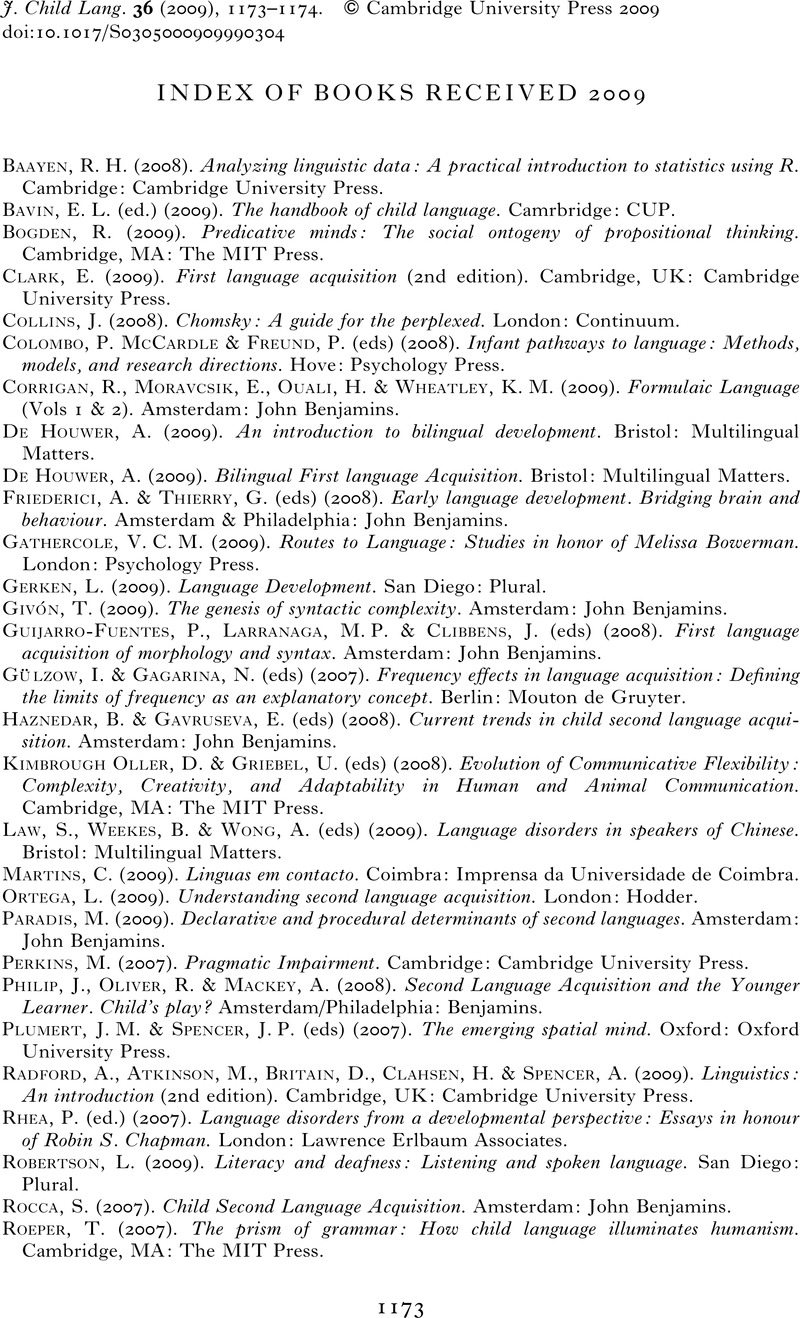No CrossRef data available.
Article contents
INDEX OF BOOKS RECEIVED 2009
Published online by Cambridge University Press: 22 October 2009
Abstract
An abstract is not available for this content so a preview has been provided. Please use the Get access link above for information on how to access this content.

- Type
- Other
- Information
- Copyright
- Copyright © Cambridge University Press 2009
References
Baayen, R. H. (2008). Analyzing linguistic data: A practical introduction to statistics using R. Cambridge: Cambridge University Press.CrossRefGoogle Scholar
Bogden, R. (2009). Predicative minds: The social ontogeny of propositional thinking. Cambridge, MA: The MIT Press.Google Scholar
Clark, E. (2009). First language acquisition (2nd edition). Cambridge, UK: Cambridge University Press.CrossRefGoogle Scholar
Colombo, P. McCardle & Freund, P. (eds) (2008). Infant pathways to language: Methods, models, and research directions. Hove: Psychology Press.Google Scholar
Corrigan, R., Moravcsik, E., Ouali, H. & Wheatley, K. M. (2009). Formulaic Language (Vols 1 & 2). Amsterdam: John Benjamins.Google Scholar
De Houwer, A. (2009). An introduction to bilingual development. Bristol: Multilingual Matters.Google Scholar
De Houwer, A. (2009). Bilingual First language Acquisition. Bristol: Multilingual Matters.Google Scholar
Friederici, A. & Thierry, G. (eds) (2008). Early language development. Bridging brain and behaviour. Amsterdam & Philadelphia: John Benjamins.CrossRefGoogle Scholar
Gathercole, V. C. M. (2009). Routes to Language: Studies in honor of Melissa Bowerman. London: Psychology Press.Google Scholar
Givón, T. (2009). The genesis of syntactic complexity. Amsterdam: John Benjamins.CrossRefGoogle Scholar
Guijarro-Fuentes, P., Larranaga, M. P. & Clibbens, J. (eds) (2008). First language acquisition of morphology and syntax. Amsterdam: John Benjamins.CrossRefGoogle Scholar
Gülzow, I. & Gagarina, N. (eds) (2007). Frequency effects in language acquisition: Defining the limits of frequency as an explanatory concept. Berlin: Mouton de Gruyter.CrossRefGoogle Scholar
Haznedar, B. & Gavruseva, E. (eds) (2008). Current trends in child second language acquisition. Amsterdam: John Benjamins.CrossRefGoogle Scholar
Kimbrough Oller, D. & Griebel, U. (eds) (2008). Evolution of Communicative Flexibility: Complexity, Creativity, and Adaptability in Human and Animal Communication. Cambridge, MA: The MIT Press.CrossRefGoogle Scholar
Law, S., Weekes, B. & Wong, A. (eds). (2009). Language disorders in speakers of Chinese. Bristol: Multilingual Matters.Google ScholarPubMed
Martins, C. (2009). Linguas em contacto. Coimbra: Imprensa da Universidade de Coimbra.Google Scholar
Paradis, M. (2009). Declarative and procedural determinants of second languages. Amsterdam: John Benjamins.CrossRefGoogle Scholar
Perkins, M. (2007). Pragmatic Impairment. Cambridge: Cambridge University Press.CrossRefGoogle Scholar
Philip, J., Oliver, R. & Mackey, A. (2008). Second Language Acquisition and the Younger Learner. Child's play? Amsterdam/Philadelphia: Benjamins.CrossRefGoogle Scholar
Plumert, J. M. & Spencer, J. P. (eds) (2007). The emerging spatial mind. Oxford: Oxford University Press.CrossRefGoogle Scholar
Radford, A., Atkinson, M., Britain, D., Clahsen, H. & Spencer, A. (2009). Linguistics: An introduction (2nd edition). Cambridge, UK: Cambridge University Press.CrossRefGoogle Scholar
Rhea, P. (ed.) (2007). Language disorders from a developmental perspective: Essays in honour of Robin S. Chapman. London: Lawrence Erlbaum Associates.Google Scholar
Robertson, L. (2009). Literacy and deafness: Listening and spoken language. San Diego: Plural.Google Scholar
Rocca, S. (2007). Child Second Language Acquisition. Amsterdam: John Benjamins.CrossRefGoogle Scholar
Roeper, T. (2007). The prism of grammar: How child language illuminates humanism. Cambridge, MA: The MIT Press.Google Scholar
Savickiene, I. & Dressler, W. U. (eds) (2007). The acquisition of dimintuitives. Amsterdam: John Benjamins.CrossRefGoogle Scholar
Simpson, J. & Wigglesworth, G. (eds) (2008). Children and language in multilingual communities. UK, Continuum International.Google Scholar
Wang, X. (2008). Growing up with three languages: Birth to Eleven. Bristol: Multilingual Matters.Google Scholar


